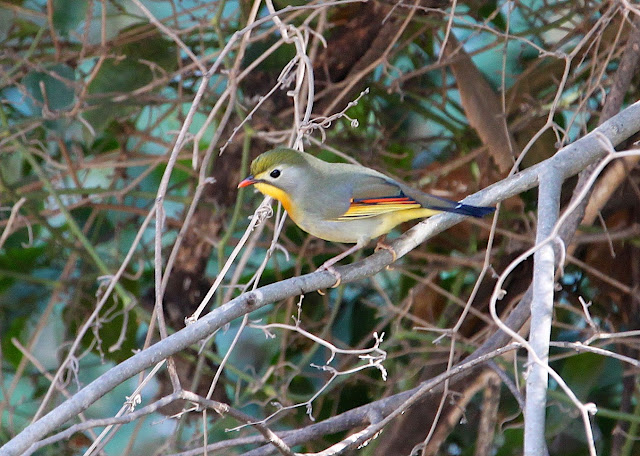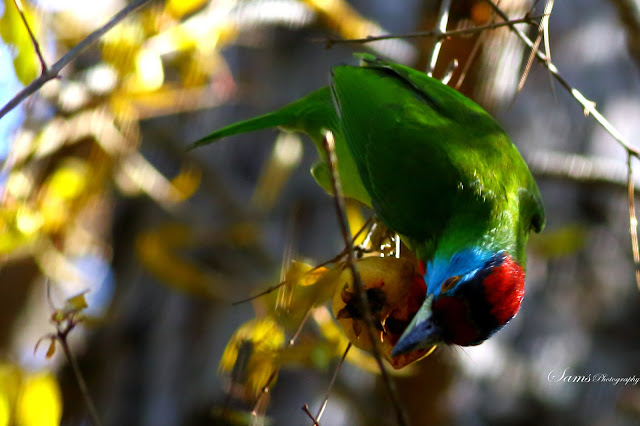ISLBIRDER Bounces Back with Two Ticks
Saturday 8 December 2012 was a memorable day for many
reasons; not least because ISLBIRDER added two more species to his Pakistan
List. However, we were lucky in other ways and by experiencing a huge
concentration of species in a very small area of deciduous woodland that
consisted of mature trees; sadly, a dwindling asset to the country’s population
and wildlife.
We began with a brisk walk to the Margalla Hills Trail 5
Spring, the scene of recent successes (and dips for some). The usual cast of regular
species were present but there were large numbers of one in particular, the
LEMON-RUMPED WARBLER. At one time the whole dell was full of them and we
searched through all to see if we could find a similarly sized Brooks’s Leaf
Warbler but to no avail. The beautiful Lemon-rumped Warblers are a joy to
behold with their long and bright supercilium, the yellowish crown stripe,
their double wing-bar and the lemon rump that provides their name. However, it
is their tiny size and arboreal acrobatics that add to the charm.
The BLUE WHISTLING THRUSH was in his usual place and Grimmo
(the Grim Gripper) managed some photographs that exemplified the richness of
the blue plumage.
 |
| Blue Whistling Thrush Grimmo |
Sam’s Photography was in his portable hide facing one way as
a family of KALIJ PHEASANT completed a song and dance routine behind him,
typical. However, Sam’s Photography came into his own later. It was Sam’s
Photography who spotted the first of ISLBIRDER’s Pakistan ticks of the day, a
beautiful ORANGE-FLANKED ROBIN or RED-FLANKED BLUETAIL as they are called in
Europe. Not only was there a male there was a first-winter male as well. After
the mega-dip of a few weeks ago it was a relief to get this blocker UTB (under
the belt).
Just when we thought the spectre of Grimmo the Grim Gripper
had disappeared than he was at it again. The now familiar MO (modus operandi)
came into play once more. “I’ve just taken a photo of a strange species”. It’s
not in the Gripper’s DNA (I don’t know what that stands for) to gently whistle
other birders to alert them to the bird. No, but he managed a few photos. Dear
Reader, I am pleased to say that you will not have to despair on behalf of
ISLBIRDER on this occasion. Grimmo had seen and photographed an uncommon winter
visitor to the area but you will be relieved to hear ISLBIRDER did not dip as
he had seen this species before in Pakistan. The bird in question was a
RUFOUS-BREASTED ACCENTOR and I’ll think you will agree it is pretty special and
also that Grimmo did a good job getting it on film or digital SD card or
whatever!
 |
| Rufous-breasted Accentor Grimmo |
One little beauty that did not evaded our accomplished
photographers, as it put in a brief appearance, was a male RUFOUS-BELLIED
NILTAVA with its dark blue mantle, electric blue crown and deep orange
underparts. I have received a complaint that I use the word underpants too
often in the blog. I can confirm the word is underparts and anyway when was the
last time anyone saw a Niltava wearing deep orange underpants.
 |
| Rufous-bellied Niltava Sam's Photography |
With a female
BLUE-CAPPED REDSTART and a BLUE-THROATED BARBET calling in the background the
WHISTLER’S WARBLER reappeared and this time Grimmo managed a record shot. This
is such a rare bird we have included the photograph here. However, Whistler’s
is such a fidget it would be a major accomplishment to capture a crisp sharp
image.
 |
| Whistler's Warbler Grimmo |
As bus loads of students had been deposited on the trail
with their accompanying cacophony of popular music we decided to move on. Our
destination was a valley we had explored before, deep into the Margallas, on
the way it was nice to a stunning male BLACK REDSTART. Not long after we
arrived a party of four HIMALAYAN GRIFFON floated overhead both in immature and
adult plumage. Vultures are becoming extremely rare in Pakistan due to the drug
diclofenac being used to inject livestock that, if scavenged, causes renal
failure in Vultures. It had been sometime since I had seen a Vulture so it was
great to see these. It became fairly quiet although there were plenty of
BLACK-THROATED JAY flying around. We decided to explore the nearby woodland. We
were so glad we did. First we found some RED-BILLED LEIOTHRIX and lured them
close enough for photography using their recorded song.
 |
| Red-billed Leiothrix Grimmo |
We ventured deeper into the wood and found a pair of RUFOUS
SIBIA. There was no hiding ISLBIRDER’s excitement; this was a species high on
the wants list and now it was a tick, a fantas-tic. Amazing that Sam’s
Photography captured the moment just before the Rufous Sibia swallowed a berry.
 |
| Rufous Sibia Sam's Photography |
A WHITE-CHEEKED NUTHATCH and two BROWN-FRONTED WOODPECKER
caught our attention but so did the mixture of agitated birdcalls that were
focussed on a tree nearby. We were sure it was either an Owl or a snake and as
most sensible snakes would be wrapped up somewhere warmer it had to be an Owl.
And so it was, a SPOTTED OWLET that got so fed up with being mobbed by smaller
birds it flew into the tangle of a nearby tree. The mobsters included BLUE-THROATED
BARBET, a male BLUE-CAPPED REDSTART, GREY TREEPIE, RUFOUS TREEPIE, GREENISH
WARBLER, RED-BILLED LEIOTHRIX, BLACK BULBUL, VARIEGATED LAUGHINGTHRUSH,
STREAKED LAUGHINGTHRUSH, GREY-HOODED WARBLER, GREEN-BACKED TIT and CINEREOUS
TIT. So, dear readers buy a toy owl and nail it to a tree then sit back and
enjoy the show.
 |
| Blue-throated Barbet Sam's Photography |
A great day with a grand total of 43 different species. ISLBIRDER sincerely thanks the brilliant photographers who are not only my companions on birding trips but who are so kind in allowing me to use their photographs on this blog.


